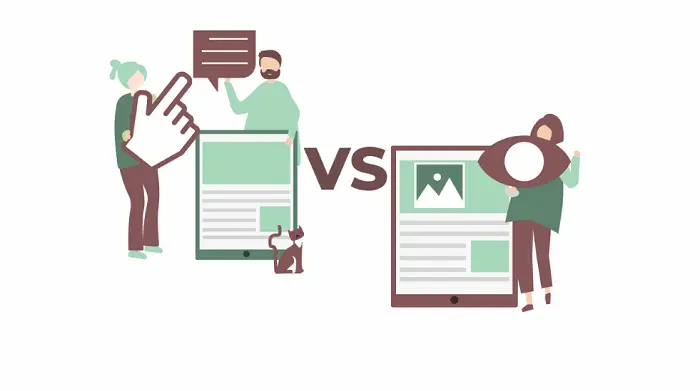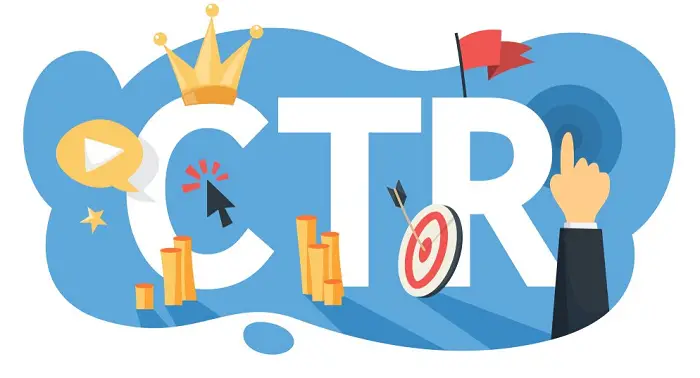Are you confused about the terms “impression” and “click” when it comes to website analytics? In this article, we will clarify the key differences between website impressions and clicks.
Website Impression refers to the number of users interacting while visiting or seeing your application, advertisement, or link in search results, resulting in statistics increment impression. Clicks represent the number of times a user has clicked on the link of your application, which sends the user out from the Google search query page and lands it on that web page or application.
You can gain valuable insights into your website’s performance by understanding the differences between impressions and clicks. Keep reading to have a better understanding of both the terms.
See Also: 7 Places to Outsource Content – Best Content Writing Services
Importance of Impression
A Simple answer to why impressions are important for an application to grow.
- One of the popular methods of buying advertisements for an application is the amount of impression generated by an advertisement or website. The revenue rent system for advertisement is based on Cost per Mille (CPM), but sometimes advertisement renting is based on per thousand impressions.
- They provide a simple idea for marketing analysts to host their advertisement on which application to attract more audiences.
- Calculating an impression also helps calculate and analyze the accuracy and reach of an advertising medium. And also, whether it will be beneficial to go through that communication channel to reach out to the audience.
Importance of Clicks
- The critical aspect is ad clicks because they decide how effective your ad is to get people to click on the desired website to visit, whether for purchasing or selling a product, renting services, visiting a website, or Signing In for use regularly.
- They are used to measure how well an advertisement is performing and can be performed if hosted and how much the audience can be attracted while scrolling and managing to convert the audience to sales driven.
- The measurement of the best-performing ad can be done through the formula of ‘Click-Through-Rate’ (CTR), where the number of clicks your ad or site gets is divided by the number of impressions, and the result obtained is the actual performance.
See also: Difference Between Static and Dynamic Website
Impression Vs. Click
Both provide an idea to actual and seen visitors for the advertisement and site to attract user attention.
- This is always seen while calculating the cost per click vs. cost per impression, the first approach will be selected as an important metric, and therefore charges vary on the basis of a single click. This is because clicks are a leading indicator when considering users interested in what you’re offering them.
- However, the advertising campaign goals decide whether clicks and impressions are important to reaching higher users. When selling a product or service which requires more consideration from desired customers (for example – a watch for selling or maintenance service), the focus will be more on making people remember the brand name and what you sell and offer them. In this scenario, the first approach will be considered more important while comparing impressions vs. clicks will be the first approach.
If you are confused considering which approach best suits your business, try both of them and analyze the data accordingly to compare which would be more important.
See Also: 14 Lead-Generating B2B Marketing Strategies (2024)
How impressions are counted
Depending upon the setting selected to filter the performance report of an impression, when there are many links within a single link, it is measured by URL or by property.
This can be understood through this Image example: the performance measuring through property vs. URL.
If the system measure performance by grouping by the property, the impression count will be 1.
Example: www.example.com – Impression 1
But while measuring performance grouped by URL, the impression count changes.
Let’s see: www.example.com – Impression 1
www.example.com/shamrock – Impression 1
www.example.com/rainbow – Impression 1
www.example.com/rain – Impression 1
www.example.com/lightning – Impression 1
The total count of impressions comes to 5, which is much higher than measuring through the property.
However, there are many other mechanisms to count the number of impressions according to different elements.
Improving CTR through Impression vs. Click
To obtain improved Click-Through-Rate, these three major ways might be useful.
Optimize your Title
Providing a suitable and interesting title to content is a challenging skill to perfect. It is easy to shortlist content, but I still experience writing migraines when dealing with writing titles. Fortunately, there are few guidelines that can assist in writing an appropriate title.
- Use Emotions
- Rely on Numeric Values
- Be Relatable
Optimize your Meta Description
A meta description is a text which provides an introduction to the site. Meta Description should contain an important and valuable keyword.
URLs Optimization
Structuring URLs is also an important and non-trivial task. Some of the features to modify URLs.
- Better vocabulary and readable by humans highlighting link evaluability.
- Keyword in URLs
- Avoid Dynamic Parameters where you can
- Shorter is better than longer
See Also: 11 Types of Hyperlinks You Should Know About
Facebook Relevance
While most of the other agencies and organizations use the CPM technique for their revenue system from impression vs. click, Facebook sent a curveball into the mix with its algorithm and optimized cost per mile (OCPM) metric. The main distinction between OCPM and CPM, which both involve paying for impressions, is the use of Facebook’s platform.
Facebook strives to optimize your spending rather than just throwing your entire budget at the first thousand or so individuals that see your advertisement. Even if you only pay for impressions and not clicks, it detects those who are most likely to actually click your advertising.
Convert Impression to Clicks
Converting impressions to click terms consist of a broad range of action. Still, the simple mechanism is total money spent on advertising compared to the total money received is the rate of return.
If a website has a lot of impressions but not clicks, the desired conversion cannot be met.
Some Tips to Follow
- Start including the top 100 keywords to target while gradually focusing on them. Then reduce the list to the top 50 and then the top 10. If starting with a modest set of keywords, there will be only one or two successful keywords.
- Use negative keywords whenever feasible to ensure your product does not appear in unrelated searches.
- Making ads localized and targeted towards considering the regional characteristics and parameters of the current area, such as a local event, climate, product, or service.
- Whenever utilizing Google CPC, look for the quality score. The relevance of ad texts and images and keyword score affect this value.
See Also: How To Do LinkedIn Ads Management Properly?
FAQ
What does Pay-Per-Click Advertising Mean?
Pay-per-click also refers to as PPC, is an advertising package pricing strategy to purchase the block for your ad. PPC strategies need you to pay for each click that your advertising obtains. The CPM (cost per mille) model, in contrast, charges you for every thousand impressions of your advertisement, independent of how many clicks it generates. PPC advertisements support the expansion of both new businesses and existing brands online.
What are Better CPM ads or CPC ads?
CPM and CPC are two sides of one coin. They both involve payment schemes, how to utilize your spending, and the benefits you receive from it. Cost per click, or CPC. Ads displayed to folks who don't click are free; you only pay for clicks. Cost per mille, per thousand, or CPM. Impressions are indicated by the thousands. You must pay to have someone view your advertisement, whether or not they click.
What is Query Refinement?
When you click on a link, it performs a new query in the search result tab; this is called query refinement. This can be understood using an example - if you search for 'electric vehicle,' the result might include images, news, and videos of different vehicles. Click any of the images, articles or videos performs a new search query and land on that web page but doesn't leave Google Search.
What is the Difference Between Clicks and Visits?
Visits represent the number of distinct sessions connected to each visitor, whereas clicks represent the number of times a user clicks on an advertisement. For example - an ad can be click several times by the same user, which records for several clicks in one session, whereas visits are recording only once, which are made by a single unique visitor. Any user can access a website by clicking on an advertisement, and they can return to it by selecting any bookmark URL. If they occur during distinct sessions, visits via bookmarks and ad clicks can produce several visits from a single click.
Conclusion
Impression vs. click or both is an important aspect of SEO, marketing, and mechanism. They measure the success of your digital paid advertising campaigns. It helps the organization and freelancer decide how much it is worth to pay-per-click or pay-per-impression for campaign advertisement and to select which site and block within the site will provide you a better rate of return.
Impression and clicks increase the value of hosting advertisements by their maximum score as well as Click-Through-Rate (CTR), and for some organizations, become their revenue system. Hence analysis and measuring of technique is an important part of which creates the base for advertisement strategies. Similar to the human first impression, which gives an idea of his personality, they provide personality and demand value of an application.
See Also: Spam Backlinks: How To Find Toxic Links For Better SEO?





